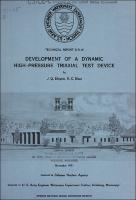Please use this identifier to cite or link to this item:
https://hdl.handle.net/11681/20566| Title: | Development of a dynamic high-pressure triaxial test device |
| Authors: | United States. Defense Nuclear Agency Ehrgott, John Q., Jr. (John Qua), 1970- Sloan, Richard C. |
| Keywords: | Dynamic pressure Ground shock Rock properties Rock test specimens Test equipment Triaxial tests Soil mechanics |
| Publisher: | U.S. Army Engineer Waterways Experiment Station. Engineer Research and Development Center (U.S.) |
| Description: | Technical Report Abstract: A unique dynamic high-pressure triaxial test device has recently been developed at the U.S. Army Engineer Waterways Experiment Station to assist in obtaining dynamic stress-strain and strength data for use in formulating soil and rock constitutive relations used in blast-induced ground shock calculations. The device is capable of imposing controlled impulsive-type confining pressures up to 15 kips/in² on specimens up to 3 inches in diameter; peak pressures can be achieved in as little time as 3 msec, and all pressure can be removed in 20 msec. These dynamic confining pressures can be time-synchronized with similar dynamic axial load pulses with magnitudes up to 100 kips. Independent control of the axial and radial stresses permits application of dynamic hydrostatic loadings and unloadings to obtain bulk moduli; dynamic deviatoric loadings under constant confining pressure to obtain Young's moduli and yield stress data; dynamic deviatoric loadings while maintaining a condition of constant mean normal stress to obtain shear moduli; and a variety of other loadings including constant stress ratios. This report presents a description of the dynamic high-pressure triaxial device, which consists basically of five components, i.e., the rise pressure supply system, the decay system, the base assembly, the triaxial chamber, and the stroke limiter. Details of the measurement systems used for determination of confining pressure, axial load, and axial and lateral deformation under dynamic high-pressure fluid environments are given. Several results from an evaluation test series conducted on field NX-size cores of a clayey siltstone and Cretaceous sandstone are presented to demonstrate some of the capabilities of the device and to show the type of dynamic stress paths the device is capable of generating. The data are shown as time-history plots of confining pressure and axial load for the complete hydrostatic and shear phases of the tests along with the corresponding stress path plots of deviator stress versus mean normal stress. Deviator stress versus axial strain plots are also shown for the shear phase. The results illustrate that the device is not only useful in site investigations in which determination of dynamic properties of the material encountered is required for engineering design purposes, but also in fundamental research studies to determine material behavior under a variety of states of impulsive-type stresses. NOTE: This file is large. Allow your browser several minutes to download the file. |
| Rights: | Approved for public release; distribution is unlimited. |
| URI: | http://hdl.handle.net/11681/20566 |
| Appears in Collections: | Technical Report |
Files in This Item:
| File | Description | Size | Format | |
|---|---|---|---|---|
| TR-S-71-15.pdf | 28.74 MB | Adobe PDF |  View/Open |